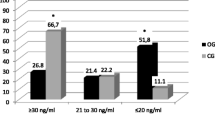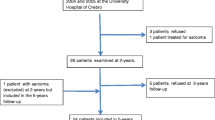Animal studies have demonstrated that the highest concentration of vitamin D receptors (and greatest capacity for active calcium absorption) occurs in the proximal duodenum. By passing the duodenum following Polya/Billroth II gastrectomy could result in the development of a metabolic bone disease and low bone mineral density (BMD). We thus compared the vitamin D receptor (VDR) concentration in mucosal biopsies taken at endoscopy from two functionally corresponding areas of the small intestine: the jejunum (or efferent loop) in 21 patients with a history of Polya/Billroth II gastrectomy and the second part of the duodenum in age/sex-matched control subjects. We also measured the BMD by dual energy X-ray absorptiometry. The mean VDR concentration was not significantly different between the two groups (patients vs controls, fmol/mg protein, mean ± SE: 34.99 ± 2.57 vs 34.67 ± 3.71; P = 0.22), even when subgrouped as males (36.22 ± 3.16 vs 31.2 ± 4.24; P = 0.351) or females (31.93 ± 4.7 vs 43 ± 6.76; P = 0.193). In Polya/Billroth II gastrectomy patients, the VDR concentration in the efferent loop declined with age (r = -0.78, P = 0.02). In the same group, BMD, as compared with matched controls, was significantly reduced at the lumbar spine (Z-score: patients vs controls: -1.138 vs 0.099, P = 0.01), but not at the femoral neck (Z-score: -0.69 vs 0.7, P = 0.084). There was no correlation between VDR and time since operation or BMD. These results suggest that following Polya/Billroth II gastrectomy, the functional capacity of the jejunal efferent loop in reference to VDR concentration is similar to that of the second part of the duodenum in normal subjects. Therefore, the reduced BMD in our patients, also a common finding in other studies, may not be secondary to the reduced capacity of the VDR system that facilitates the active calcium transport pathway in the proximal small intestine.
Similar content being viewed by others
Author information
Authors and Affiliations
Rights and permissions
About this article
Cite this article
Pazianas, M., Zaidi, M., Subhani, J. et al. Efferent Loop Small Intestinal Vitamin D Receptor Concentration and Bone Mineral Density after Billroth II (Polya) Gastrectomy in Humans . Calcif Tissue Int 72, 485–490 (2003). https://doi.org/10.1007/s00223-001-2135-2
Received:
Accepted:
Issue Date:
DOI: https://doi.org/10.1007/s00223-001-2135-2




